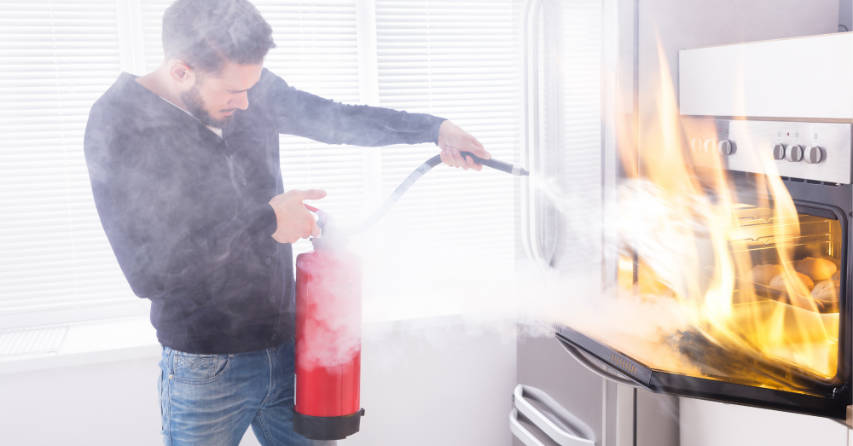
Fire is one of the leading causes of home insurance claims — but luckily, it’s also one of the most preventable. Whether you rent or own your home, it’s a good idea to have a fire extinguisher on hand, learn how to use it before you need to, and keep it properly maintained so it works if you ever have to reach for it.
There are four main elements essential to any fire: heat, oxygen (or another oxidizing agent), fuel, and a chemical reaction. To put it simply, a fire extinguisher releases a chemical or other fire-suppressant material that gets rid of at least one of these essential elements — and that puts an end to the fire. The ingredients used in fire extinguishers vary depending on the type of fire you’re dealing with, but the most common ingredients include water, sodium bicarbonate (known in your kitchen as baking soda), and carbon dioxide.
A fire extinguisher contains a limited amount of extinguishing agent and it can run out in a matter of seconds, so you should only ever use one on a small fire. You’ll need to act fast once you pull the trigger, too.
If a fire breaks out and it looks small enough to manage on your own — without endangering yourself or others — grab your fire extinguisher. Then, stand about three metres away from the fire (between the room’s nearest exit and the fire) and begin the “PASS” technique:
It’s worth noting that while most fire extinguishers work with the PASS method, some require different steps. Be sure to read the instruction manual that came with your extinguisher for specific directions.
Store your fire extinguisher close to your escape route, in a location where it will be easily accessible if you need to grab it in a hurry. Whether it’s mounted on the wall or placed on a shelf, it should always be stored in plain view, away from potential fire hazards, and between a likely fire location (like your stove, for example) and the room’s exit. Never store your fire extinguisher in a location that would result in the fire blocking your exit while you try to put it out.
Consider placing at least one fire extinguisher on each level of your home, especially in areas where a fire is most likely to break out, like the kitchen, your workshop, the garage, and rooms with fireplaces or wood stoves.
Fires are grouped into classes based on the materials or substances that are present, and different fire extinguishers are required for each class of fire. The Canadian Centre for Occupational Health and Safety This is an external link (CCOHS) lists the five fire classes as follows:
For home use, the CCOHS recommends a multi-purpose dry chemical fire extinguisher labelled ABC, which is good for extinguishing most fires that fall under classes A, B, and C.
Even if your fire extinguisher goes unused year after year (which we consider a good thing!), it does have a shelf life and require servicing. You should have your fire extinguisher serviced by a qualified professional every six years, and you should get a new one every 12 years.
Each month, do a quick visual inspection of your fire extinguishers:
As soon as you break the seal on your fire extinguisher, even if you don’t empty it completely, you should either replace it or take it in to be serviced.
You should have your fire extinguisher serviced by a qualified professional every six years, and you should get a new one every 12 years.
A fire can do a lot of damage to your home — even if it’s just a small fire and you put it out quickly. The good news is the majority of home insurance and tenant insurance policies cover damage caused by accidental fires and accompanying smoke. To find out exactly how your coverage would respond in the event of a fire, contact your licensed home insurance broker or review your policy documents.